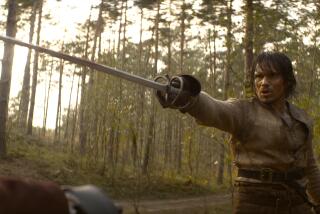‘Notre Dame’ a Success in Its Hometown
- Share via
PARIS — If any audience might have been expected to spurn the Disneyfied version of “The Hunchback of Notre Dame,” it was the French.
After all, this nation symbolically owns the historical rights to Victor Hugo, author of the 1831 novel on which the animated film is very loosely based. The 12th century cathedral is arguably the greatest of the great monuments of Paris. The people of France like to defend their culture against American influence, not send it back for a rewrite.
So when the movie opened here at the end of November, even the Disney people were holding their breath. Would the myriad plot departures from the book, which have produced acres of negative press in the United States and Britain, anger a French public raised on Hugo? Would the defenders of French history and culture rise up in horror at the happy ending, the cheery songs, the dancing gargoyles?
They need fear no more. “Le Bossu de Notre Dame,” as the film is called in French, has been the movie hit of the Christmas season. For three straight weeks it was the biggest-selling movie in the Paris region and across the country. Nearly 3 million tickets have been sold. “Hunchback,” or “Bossu,” merchandise fills the stores of Paris. Film critics have been positive; the intellectual elite is silent.
In fact, “Hunchback” has even penetrated cultural life here. In the historic Place des Vosges, where Hugo’s former home is now a museum that enshrines his life, an exhibition on the book and the movie has been mounted by a joint venture of Disney, the museum and the city of Paris.
There, visitors can compare about 200 works from Disney animation studios--some of them early studies, others finished frames--with historical depictions of Notre Dame, of Paris in the 15th century, when the plot of the book and movie are set, and of the characters in the book. Hugo himself dabbled in art; his dark watercolors of Notre Dame’s towers and other Paris scenes startlingly resemble the imagery of the film.
“I never thought [mounting the exhibition] would be a sacrilege,” said Danielle Molinari, chief conservator of the museum. “Hugo was the first of the moderns. He was not for an elitist culture. I think Victor Hugo would be happy to see his work being reborn in the hands of great professionals.”
Disney animators spent several months here researching the look and feel of Paris in the Middle Ages. They visited the National Library, where they perused folios and texts from the period, as well as engravings of Notre Dame from Hugo’s time. They were given a private tour of the cathedral and of Paris’ few remaining 15th century buildings and visited the former site of the Court of Miracles, where Hugo’s Gypsies gathered.
“We knew when we started this thing that we were treading on holy ground,” said Roy Conli, producer for Walt Disney Feature Animation (France).
As it happens, about 20% of the movie was created in a studio just outside Paris in the suburb of Montreuil, which Disney has owned since 1989. It was a coincidence that this was the first Disney animation movie in which portions were farmed outside the United States and that the studio that did the work was located in the hometown of Quasimodo, the tale’s title character.
But the use of the studio also may have helped quell French critics. In any case, the reviews of “Hunchback” have been, if not glowing, largely positive. The newspaper Liberation said that it “varied from the sacred to the sweet” and that the cathedral was “the real heroine.” Telerama magazine, an influential cultural publication, complained about the “crude happy end, more like Broadway than Hugo” but added: “Altogether, one finds the spirit of the novel, its Gothic ambience, its social effervescence.”
More to Read
The biggest entertainment stories
Get our big stories about Hollywood, film, television, music, arts, culture and more right in your inbox as soon as they publish.
You may occasionally receive promotional content from the Los Angeles Times.










